
Flying scissors to the neck. The opponent is forced to the ground with a twist of the body.

Vietnamese martial art artifact from the 17th century at Vietnam National Museum of Fine Arts - Hanoi, Vietnam.

Fragment of jar with warriors fighting, 13th-14th century. National Museum of Vietnamese History, Hanoi.

Painting depicting soldiers practicing during the Revival Lê dynasty, 1684-1685
| Part of a series on |
| Vietnamese martial arts |
|---|
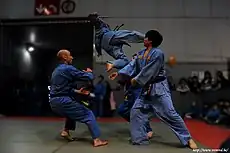 |
| Part of a series on the |
| Culture of Vietnam |
|---|
 |
| History |
| People |
| Languages |
| Cuisine |
| Festivals |
| Literature |
| Music |
| Sport |
Traditional Vietnamese martial arts (Võ thuật Cổ truyền Việt Nam; Chữ Hán: 武術古傳越南) often referred to as Võ thuật (Chữ Hán: 武術), can be loosely divided into those of the Sino-Vietnamese descended from the Han and those of the Chams or indigenous Vietnamese.
Traditional schools
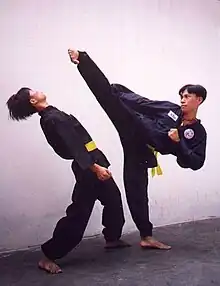
Võ Tân Khánh Bà Trà

Võ Cổ truyền
- Võ thuật Bình Định/Bình Định Gia – umbrella title for all the traditional styles of Bình Định in central Vietnam.
- Võ Lâm Tân Khánh Bà Trà - The Tân Khánh martial arts was established in the 17th century. It was developed as a method of self-defense against enemies and wild animals.[1]
- Traditional Vietnamese wrestling.
Modern schools
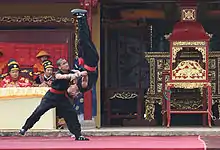
Võ thuật performance at Huế Festival 2008
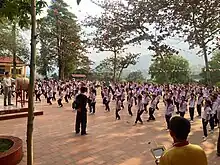
The students of an elementary school learn martial arts in the school
Modern styles, or Phái (schools), include:
- Nhất Nam
- Vovinam – Founded by Nguyễn Lộc. Also called Vovinam Việt Võ Đạo (Việt = Vietnamese, Võ = martial, Đạo = way)
- Võ Việt Nam (Cuton) or Võ Đạo of Phạm Văn Tan.[2]
- Vietnamese Wing Chun - a style of Wing Chun founded by Yuen Chai-wan.[3]
- Overseas
- Cuong Nhu of Ngô Đồng (d. Florida 2000), known also by the Japanese title O Sensei.
- Qwan Ki Do, founded in France.[4]
- Tam Qui Khi-Kong, now popular in Russia.
- Traditional Vietnamese wrestling.
Terminology
- võ sư – master
- võ phục – tunic
- võ kinh – martial arts scripture
- Võ Bắc Việt – Northern Vietnam style
- quyền – fist, such as Hùng kê quyền, Hồng Gia quyền, Lão mai quyền
- Võ thuật Bình Định – martial arts of Bình Định
- Đấu vật – ring wrestling (can also mean western wrestling)
- Hand techniques (đòn tay)
- Elbow techniques (chỏ)
- Kicking techniques (đá)
- Knee techniques (gối)
- Forms (Quyền, Song Luyện, Đa Luyện)
- Attack techniques (chiến lược)
- Traditional wrestling (Vật cổ truyền)
- Leg Attack take-downs (đòn chân tấn công)
- Staff (côn)
- Sword (kiếm)
- Halberd (dao dài, "long knife")
- Rope dart/chain whip (nhuyễn tiên, different from Chinese rope dart)
- Khăn rằn - The khăn rằn is a southern scarf that originated from the Khmer krama scarf.[5] The khan ran can be used to lock the enemy's arm, lock the enemy's wrist, lock the enemy's leg, pull the enemy's leg and to attack the enemy's face.[6]
Gallery
_01.jpg.webp) An illustration of a martial arts competition in the Nguyễn dynasty – Part 1
An illustration of a martial arts competition in the Nguyễn dynasty – Part 1_02.jpg.webp) An illustration of a martial arts competition in the Nguyễn dynasty - Part 2.1
An illustration of a martial arts competition in the Nguyễn dynasty - Part 2.1_01.jpg.webp) An illustration of a martial arts competition in the Nguyễn dynasty – Part 2.2
An illustration of a martial arts competition in the Nguyễn dynasty – Part 2.2.jpg.webp) An illustration of a martial arts competition in the Nguyễn dynasty – Part 3
An illustration of a martial arts competition in the Nguyễn dynasty – Part 3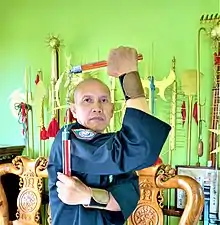 Master Hà Dũng performs nunchaku
Master Hà Dũng performs nunchaku
See also
References
- ↑ Bao, Q. (n.d.). Huyền thoại Võ lâm Tân Khánh Bà Trà [Legend of Vo Lam Tan Khanh Ba Tra]. Thanh Nien. Retrieved February 14, 2022, from https://thanhnien.vn/huyen-thoai-vo-lam-tan-khanh-ba-tra-post1422928.html
- ↑ Gabrielle Habersetzer; Roland Habersetzer (2004). Encyclopédie des Arts Martiaux d'Extrême-Orient: Technique, historique, biographique et culturelle.
A la veille de l'indépendance du Vietnam (1955) différents groupements. sous le couvert d'associations sportives. virent le jour. avec notamment le mouvement Vovinam de Nguyen-Loc. le Tinh-Vô-Hoi (arts martiaux sino-vietnamiens) avec entre autres Chau Quan Ky. le Vo-Vietnam (Cuton) ou encore le Vu-Dao (Pham Van Tan*). Ces groupements connurent une structuration plus forte dans le cadre du Sud Vietnam dans les années 1960. avec. notamment. la création du Tong-Hoi-Vo-Hoc-Viet-Nam ..
- ↑ The Vietnamese Wing Chun - Vinhxuan. (n.d.). Barnes & Noble. Retrieved May 15, 2022, from https://www.barnesandnoble.com/w/the-vietnamese-wing-chun-vinhxuan-igor-dudukchan/1121208328
- ↑ Tătaru, Irene Teodora (2021). "Basic Arm Techniques in Qwan Ki Do". Bulletin of the Transilvania University of Brasov Series IX, Sciences of Human Kinetics. 14 (1): 101.
- ↑ Tuyển, D. (2021, March 23). Khăn rằn mang lại bình an và may mắn [Scarves bring peace and good luck]. Thoi Trang Tre. Retrieved February 28, 2022, from https://thoitrangtre.thanhnien.vn/khan-ran-mang-lai-binh-an-va-may-man-post1384170.html
- ↑ The uniqueness of Khan Ran martial arts. (2020, May 25). Vietnam Pictorial. Retrieved February 8, 2022, from https://vietnam.vnanet.vn/english/tin-tuc/the-uniqueness-of-khan-ran-martial-arts-224041.html
This article is issued from Wikipedia. The text is licensed under Creative Commons - Attribution - Sharealike. Additional terms may apply for the media files.